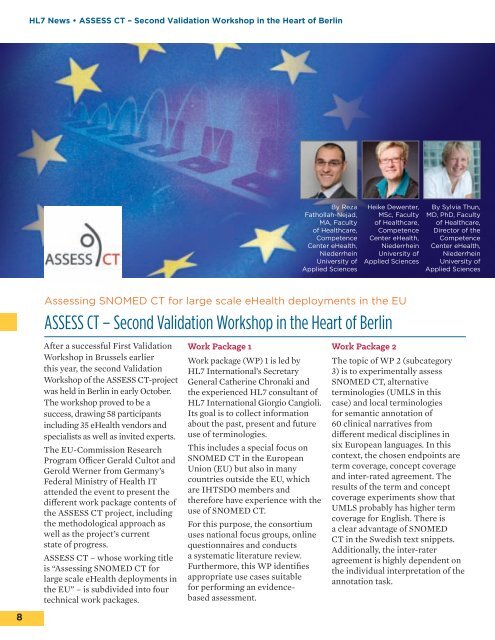In this Issue HL7 News
HL7_NEWS_20160111
HL7_NEWS_20160111
Create successful ePaper yourself
Turn your PDF publications into a flip-book with our unique Google optimized e-Paper software.
<strong>HL7</strong> <strong>News</strong> • ASSESS CT – Second Validation Workshop in the Heart of Berlin<br />
By Reza<br />
Fathollah-Nejad,<br />
MA, Faculty<br />
of Healthcare,<br />
Competence<br />
Center eHealth,<br />
Niederrhein<br />
University of<br />
Applied Sciences<br />
Heike Dewenter,<br />
MSc, Faculty<br />
of Healthcare,<br />
Competence<br />
Center eHealth,<br />
Niederrhein<br />
University of<br />
Applied Sciences<br />
By Sylvia Thun,<br />
MD, PhD, Faculty<br />
of Healthcare,<br />
Director of the<br />
Competence<br />
Center eHealth,<br />
Niederrhein<br />
University of<br />
Applied Sciences<br />
Assessing SNOMED CT for large scale eHealth deployments in the EU<br />
ASSESS CT – Second Validation Workshop in the Heart of Berlin<br />
After a successful First Validation<br />
Workshop in Brussels earlier<br />
<strong>this</strong> year, the second Validation<br />
Workshop of the ASSESS CT-project<br />
was held in Berlin in early October.<br />
The workshop proved to be a<br />
success, drawing 58 participants<br />
including 35 eHealth vendors and<br />
specialists as well as invited experts.<br />
The EU-Commission Research<br />
Program Officer Gerald Cultot and<br />
Gerold Werner from Germany’s<br />
Federal Ministry of Health IT<br />
attended the event to present the<br />
different work package contents of<br />
the ASSESS CT project, including<br />
the methodological approach as<br />
well as the project’s current<br />
state of progress.<br />
ASSESS CT – whose working title<br />
is “Assessing SNOMED CT for<br />
large scale eHealth deployments in<br />
the EU” – is subdivided into four<br />
technical work packages.<br />
Work Package 1<br />
Work package (WP) 1 is led by<br />
<strong>HL7</strong> <strong>In</strong>ternational’s Secretary<br />
General Catherine Chronaki and<br />
the experienced <strong>HL7</strong> consultant of<br />
<strong>HL7</strong> <strong>In</strong>ternational Giorgio Cangioli.<br />
Its goal is to collect information<br />
about the past, present and future<br />
use of terminologies.<br />
This includes a special focus on<br />
SNOMED CT in the European<br />
Union (EU) but also in many<br />
countries outside the EU, which<br />
are IHTSDO members and<br />
therefore have experience with the<br />
use of SNOMED CT.<br />
For <strong>this</strong> purpose, the consortium<br />
uses national focus groups, online<br />
questionnaires and conducts<br />
a systematic literature review.<br />
Furthermore, <strong>this</strong> WP identifies<br />
appropriate use cases suitable<br />
for performing an evidencebased<br />
assessment.<br />
Work Package 2<br />
The topic of WP 2 (subcategory<br />
3) is to experimentally assess<br />
SNOMED CT, alternative<br />
terminologies (UMLS in <strong>this</strong><br />
case) and local terminologies<br />
for semantic annotation of<br />
60 clinical narratives from<br />
different medical disciplines in<br />
six European languages. <strong>In</strong> <strong>this</strong><br />
context, the chosen endpoints are<br />
term coverage, concept coverage<br />
and inter-rated agreement. The<br />
results of the term and concept<br />
coverage experiments show that<br />
UMLS probably has higher term<br />
coverage for English. There is<br />
a clear advantage of SNOMED<br />
CT in the Swedish text snippets.<br />
Additionally, the inter-rater<br />
agreement is highly dependent on<br />
the individual interpretation of the<br />
annotation task.<br />
8


